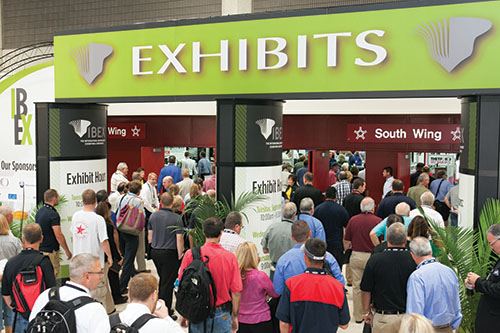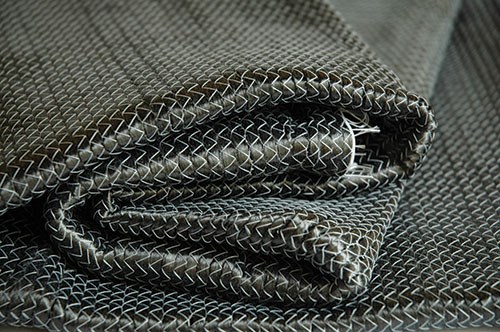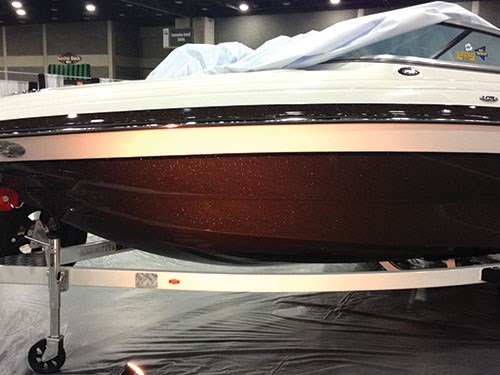IBEX 2013 Show Review
Evidence of a marine industry rebound and a trend toward supplier M&A as the world’s largest boatbuilding trade show looks ahead to smoother sailing … and Tampa.
Although the mood was positive and activity on the show floor was energetic at the International Boatbuilders Exhibition and Conference (IBEX), attendance was flat — officially “equal to last year” at 4,700 attendees. Held Sept. 17-19 at the Kentucky Exposition Center (Louisville, Ky.), the event’s lower-than-anticipated turnout baffled many observers because the marine industry’s rebound is picking up speed.
Info-Link Technologies (Miami, Fla.) reports that sales of powerboats more than 15 ft/5m in length have shown their third consecutive year-to-year gain, nearing 10 percent annual growth, based on new boat registrations. In his “State of the U.S. Recreational Boating Industry” report at the IBEX All-Industry Breakfast, Thom Dammrich, president of IBEX cohost the National Marine Manufacturers Assn. (NMMA, Washington, D.C.), announced encouraging 2012 statistics: Americans spent 3 billion hours on boats, with 88 million people boating and 300 million boat trips, the highest level of participation since NMMA began keeping records. Although annual retail powerboat sales are still way below the prerecession high water mark of 300,000 units, they are rising, approaching 160,000 units last year after their 2010 plunge to 142,000 units (down 55 percent).
Exhibitors in the IBEX Composites Pavilion were not sure why IBEX attendance did not reflect marine production increases, but they expressed excitement that in 2014 the show will cast off from its inland site in Louisville to new moorings in Tampa, Fla. Located on the waterfront, close to hotels and attractions, the Tampa Convention Center is a world-class event space. One exhibitor said of the return to Florida that “99 percent of our customers are within a few hours drive.” Another noted, “I think we’ll see more attendees from each shop if they can drive and don’t have to lose so many work days.”
The question now is how the industry will respond. Rick Pitino, head basketball coach for the University of Louisville and IBEX 2013 keynote speaker, challenged, “If you face adversity, what will get you through, every time, is your dedication and your passion.” Dammrich, in his presentation, went one step further: “We are an ecosystem — we’re all interconnected. We need the engagement of the entire industry.” He urged increased outreach to youth and minorities and an increase in hands-on training as well as continued fostering of innovation to make sure boating is strong enough to maintain and grow the 964,000 jobs and $121 billion of value it contributes to the U.S. economy.
On the subject of innovation, IBEX did not disappoint. Composites-oriented seminar titles emphasized progressive improvement: “Adapting Open Molds for Infusion”; “Prepreg Best Practices”; and “What Do You Mean: Green?,” which introduced environmentally sound options during design, build, operation and disposal. Options include the GreenStar rating from Lloyd’s Register, the use of carbon fiber fabrics made from recycled fiber and the opportunity to funnel waste from molding processes to cement factories that burn ground-up fiberglass composites as fuel that does not produce hazardous byproducts. Of note, in Stanford University lifecycle assessments — from melting sand for fiberglass through product disposal — composites bested other materials in every category of pollution. Other presentations offered practical advice: How to bond to infused laminates; Increasing productivity and cutting costs through temperature control; and Core materials selection to minimize purchasing issues while maximizing lightweighting.
Suppliers join forces
There was evidence at this year’s IBEX of what could prove to be a major trend toward mergers and acquisitions (M&A) as suppliers seek to provide wider product offerings and more customized product development. A prime example was the first IBEX exhibitor presence of ATC Scott Bader. Wollaston, U.K.-based Scott Bader North America acquired Canada-based ATC (Burlington, Ontario) in February 2013. The combined company now offers a full spectrum of solutions — from polyester bonding pastes to methyl methacrylate (MMA) structural adhesives — for composites in marine and other industries. COO Jean-Pascal Schroeder explained in his IBEX seminar, titled “Bonding to Infused Laminates,” that when stringers are bonded to infused hulls, the best solution may be a methacrylate, which offers greater toughness and elongation to meet impact resistance requirements and fill gaps between stringers and the hull. However, geometrically restrained joints, which are more rigid, have little need for such elongation, so boatbuilders need not pay the premium for the adhesive. Here, polyester bonding pastes make more sense. R&D manager Mark Cooper suggested urethane acrylate (UA) as a possible solution, which is new to North America but has been used widely in European naval vessels. “This very user-friendly alternative to MMA adhesives is a hybrid developed for U.K. minesweepers that allows using the same MEKP [methyl ethyl ketone peroxide] and pump equipment as polyester, so it is an easy transition for builders.” At its booth, ATC Scott Bader offered a wide range of Crestopol UA adhesives, and Cooper suggested stringers as an excellent application, while bonded nonstructural bulkheads are more suited for polyester adhesives. “If you are bonding composites to metals and plastics, then we have MMAs and also the ability to develop hybrids all along the spectrum.” ATC Scott Bader also presented a workshop titled “Achieving Best-in-Class Surface Finish During Infusion Processing,” which discussed using a 1-mm/0.04-inch thick Crestacoat 5000PA barrier coat backed with Crystic VE 679PA resin for dark laminates.
Polyumac USA (Miami, Fla.) also broadened its product line through its acquisition by Changzhou Tiansheng New Materials Co. Ltd. (Changzhou, China) in December 2012. Tiansheng president Xu Yi explained that Polyumac’s polyurethane, polyester and polyimide foams are complementary to its own series of Strucell products, which include polyvinyl chloride (PVC), cyclic imide and thermoplastic structural foams, as well as Rigicore P, which is made almost completely from PVC foam scraps and recycled core. Tiansheng also offers Strucell plastic honeycomb through its acquisition of Qingdao-Tubus Honeycomb Co. Ltd. (Qingdao, China). Targeting aerospace, transportation, wind energy and marine markets, Tiansheng says Polyumac provides access to the North American market and attractive patents, including one co-owned with American Airlines and another with NASA. It also sees itself as moving from a mere material supplier to a design-integrated manufacturer, offering strong R&D and a range of solutions for composites. According to national sales manager Rod Bearden, Polyumac will complete its U.S. corporate relaunch by year’s end, including a new Web site.
Illinois Tool Works (ITW) merged its Plexus, Spraycore and Devcon operations into ITW Polymers Adhesives (Danvers, Mass.) with the aim to create larger divisions focused on innovative products and improved customer service. National sales manager Tom Glast noted, “Not many people know that ITW is nearly as large as 3M, with over 800 different businesses. This new core group will draw from that corporate strength, targeting a larger product offering and tailored solutions for not just marine, but all transportation and industrial end-uses.”
Education and consultation
A continuing trend toward collaboration between suppliers and manufacturers was exemplified by Composites Consulting Group (CCG, an offshoot of DIAB Americas LP, DeSoto, Texas). CCG presented three seminars: “The Double-Bag Debate Update,” “Inside the Bag: Vacuum-Pressure Analysis” and “Infusing Stringers and Floors.” The latter was copresented by André Cocquyt (GRPguru.com, Harpswell, Maine) and dealt with infusing a hull and stringers simultaneously vs. infusing stringer systems separately. “We don’t see a size limit for co-infusing stringers with the hull,” remarked CCG Americas manager James Jones. He says, “The challenging part is vacuum bagging all of the geometry.” Jones pointed out that senior process specialist Belle Blanding worked with Midnight Express Boats (Hollywood, Fla.) to infuse a 39-ft/11.9m hull with the main longitudinal stiffeners and aft bulkhead. She notes, “It took two extra days to complete the setup but eliminated a second infusion plus all of the surface preparation and adhesive application that would have been required for secondary bonding of the stringers.” Midnight Express’ production manager, Tague Estes, says that even with that extra setup, co-infusing the stringers ends up cutting close to two days out of the overall build, plus it contributes to the removal of almost 4,000 lb (1,814 kg) from the part vs. open molding.
CCG highlighted a 95-ft/29m luxury motoryacht project at Vellroy Shipyard in São Paulo, Brazil, where Vectorworks (Titusville, Fla.) provided all naval architecture, structural, mechanical and electrical engineering. CCG supplied flow modeling and on-site infusion consultation for the hull, the deck and the 20-ft by 59-ft (6.1m by 18m) deckhouse. “Vectorworks and CCG have a long history of working together on tooling, engineering and infusion projects around the globe,” says Blanding. “For this project, the shipyard infused the aft longitudinals through the engine room with the hull, and then completed two separate infusions on their own for the forward sections, using a CCG-designed infusion manifold.”
Meanwhile, Composites One (Arlington Heights, Ill.) moved its Closed Molding University inside this year and, for the first time at IBEX, included carbon fiber/epoxy prepreg in its demonstrations. “The marine industry is starting to use more advanced materials for lightweight and higher performance,” says marketing manager Marcy Offner. Composites One carries prepreg products from Seoul, Korea-based producer Hankuk Fiber Glass Co. Ltd. Vacuum infusion demonstrations also featured Micromesh carbon fiber fabric from Vectorply Corp. (Phenix City, Ala.) and a rubber modified vinyl ester resin from CCP Composites (Kansas City, Mo.).
New, improved, expanded
First-time IBEX exhibitor CoreLite (Miami, Fla.), one of the two oldest balsa companies in Ecuador (second only to Baltek), previously served product to other suppliers. Now it markets its own balsa, which is grown, harvested and milled in Ecuador (certified by the Rainforest Alliance as meeting forest stewardship standards). The balsa is processed into finished core materials at the company’s Miami facility, the newest balsa production plant in North America. CoreLite introduced two core materials: Balsasud balsa is available from 8 to 12 lb/ft3 in a wide range of thicknesses, either rigid or contourable, with scrim and either coated or uncoated. CoreLite Board is a closed-cell PVC foam developed for high-compression and flexural properties in transoms, attachment points, floors, bulkheads, stringers and tooling. Reportedly, it can be used with or without composite skins, and it offers good fastener pullout strength and 27 percent weight savings vs. plywood.
HK Research Corp. (Hickory, N.C.) introduced its new High Definition EXTREME “METAL FLEX” in-mold polymer coating for fiberglass boatbuilders. The classic “metal-flake” look is the latest addition to HK’s expanding REVOLUTION polymer series, which boasts a grafted polymer matrix with a tighter polymer network, offering flexible crosslinks and increased weather resistance while maintaining ease of application and pricing on par with traditional gel coats. Sales and marketing VP David Higgins describes it as “the only product of its kind that allows boatbuilders to add a ‘metallic’ coating to their fiberglass parts that compares to the popular automotive paints, but REVOLUTION is truly flexible, thanks to its unique molecular structure.” HK displayed a boat from Bryant Boats (Sweetwater, Tenn.) that had been used for a year after application of the new polymer coating. The company claims it can “match any color combination imaginable,” having already done so with 2014 automotive colors for several boatbuilders. EXTREME “METAL FLEX” can be used in any in-mold boat fabrication and can be applied with traditional gel coat equipment, without any changes to production lines or processing times. It is said to be easily repairable and will yield invisible patches, which is a necessity for today’s demanding customer base.
Marine Concepts/Design Concepts (Cape Coral, Fla.) has expanded its operations into the old Wellcraft plant in Sarasota, Fla., which it purchased in November 2012. The company’s operations make use of only 140,000 ft2/13,006m2 of the facility, which houses its #5 and #6 CNC machines, so the company says it has plenty of space left for growth. “This plant produces both marine and nonmarine tooling and parts, for example, government simulation equipment and amusement park structures,” says company president Matt Chambers. He notes that diversification, customer-focused investment in the latest technology and industry talent — and a strong rebound in the marine market — enabled Marine Concepts to hire its 200th employee in late 2013, a significant recovery from a recession low of 30 employees in 2009.
MultiPanel USA LLC (Dania, Fla.) showed its rigid but easily formed polyurethane foam panel, intended as an alternative to plywood or medium-density fiberboard MDF in marine interiors and in the construction and transportation sectors. As a core and backing for veneers and cosmetic surfaces, it is waterproof and is less than one-third the weight of plywood at 25-mm/0.98-inch thick, and one-quarter the weight of 18-mm/0.71-inch thick MDF. MultiPanel-brand foam is available in 4-ft by 8-ft (1.2m by 2.4m) sheets and can be kitted.
Pro-Set Inc. (Bay City, Mich.) showcased its new 251HT hardener and 151HT epoxy resin systems for higher-temperature tooling and part fabrication. According to product manager Joe Parker, “If you need a 250°F [121°C] Tg, the 251HT hardener can be used with all standard PRO-SET resins, which allows fabrication with any process: infusion, light resin transfer molding wet bagging or contact molding. It can also produce a 350°F [177°C] Tg with a 300°F [149°C] cure when used with the 151HT resin.” The system reportedly allows 8 to 10 hours of working time at room temperature, thoroughly wets out carbon fabrics and exhibits good cosmetics in the finished part.
Zoltek Corporation (St. Louis, Mo.) showed its commercial-grade (50K) carbon fiber products for marine applications and discussed with attendees carbon fiber solutions for significant weight savings vs. fiberglass. Notably, the company pointed out that Panex 35 unidirectional and multidirectional fabrics feature sizings that are optimized to infuse well with vinyl ester resins commonly used in marine applications. Panex 35 prepreg tapes were said to offer efficient composite fabrication, often used as skins with foam or honeycomb cores to further reduce weight. Additionally, Zoltek provides carbon fiber application assistance to its customers.
COMPOSITESguru.com
Related Content
Achieving composites innovation through collaboration
Stephen Heinz, vice president of R&I for Syensqo delivered an inspirational keynote at SAMPE 2024, highlighting the significant role of composite materials in emerging technologies and encouraging broader collaboration within the manufacturing community.
Read MoreHow composites have become a necessity
Composites used to be one of many material options across industries and applications, but that's not the case anymore.
Read MoreCollins Aerospace to lead COCOLIH2T project
Project for thermoplastic composite liquid hydrogen tanks aims for two demonstrators and TRL 4 by 2025.
Read MoreNCC reaches milestone in composite cryogenic hydrogen program
The National Composites Centre is testing composite cryogenic storage tank demonstrators with increasing complexity, to support U.K. transition to the hydrogen economy.
Read MoreRead Next
“Structured air” TPS safeguards composite structures
Powered by an 85% air/15% pure polyimide aerogel, Blueshift’s novel material system protects structures during transient thermal events from -200°C to beyond 2400°C for rockets, battery boxes and more.
Read MoreDeveloping bonded composite repair for ships, offshore units
Bureau Veritas and industry partners issue guidelines and pave the way for certification via StrengthBond Offshore project.
Read MoreVIDEO: High-volume processing for fiberglass components
Cannon Ergos, a company specializing in high-ton presses and equipment for composites fabrication and plastics processing, displayed automotive and industrial components at CAMX 2024.
Read More
























